Deployment Overview
This document describes how to set up multi-factor authentication (MFA) for your Fortinet Firewall with AuthPoint, and configure your Fortinet Firewall to integrate with AuthPoint RADIUS.
Your Fortinet Firewall must already be configured and deployed before you set up MFA with AuthPoint.
This integration was tested with version 7.2.2 of Fortinet FortiGate 60E.
Fortinet SSL VPN Authentication Data Flow with AuthPoint
AuthPoint communicates with various cloud-based services and service providers with the RADIUS protocol. This diagram shows the data flow of an MFA transaction for RADIUS.
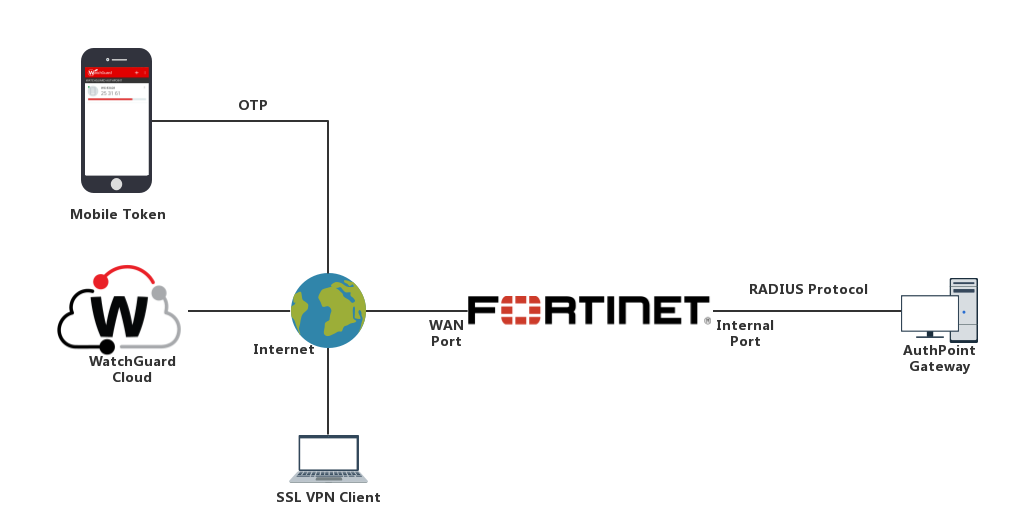
Before You Begin
Before you begin these procedures, make sure that:
- You have installed and configured the AuthPoint Gateway (see About Gateways).
- End-users can log in to the FortiGate 60E Firewall.
- You have a FortiClient V7.0.5 or higher.
- A token is assigned to a user in AuthPoint.
Configure Fortinet 60E Firewall
Configure a RADIUS Server
To use RADIUS authentication with FortiGate Firewall VPN you must add a RADIUS server (the AuthPoint Gateway). The AuthPoint Gateway functions as a RADIUS server and must be installed somewhere on your network that has Internet access and that can connect to your RADIUS clients. For more information, see About Gateways.
To configure a RADIUS server:
- Log in to the FortiGate 60E web UI at https://<IP address of FortiGate 60E>. The default IP address is 192.168.1.99
- Select User & Authentication > RADIUS Servers.
- Click Create New.
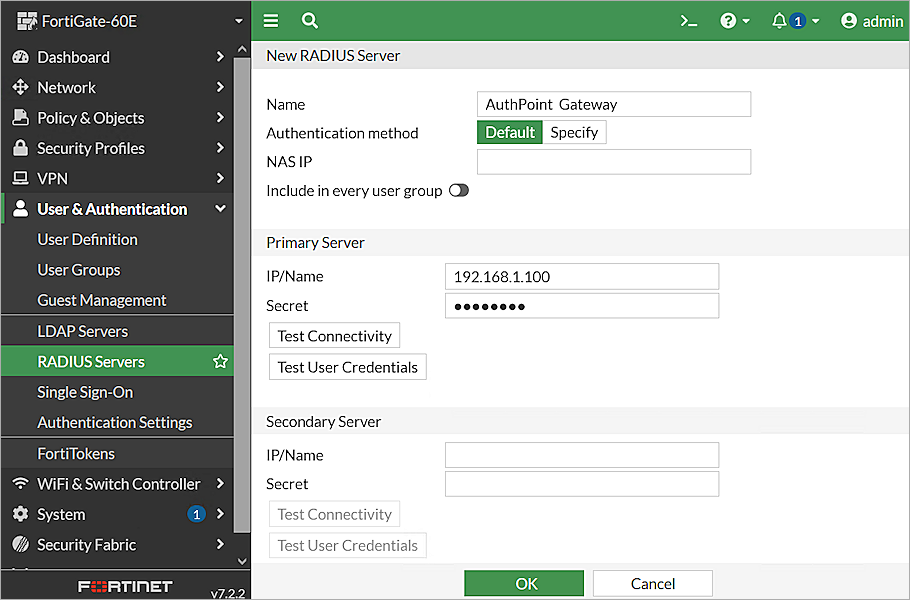
- In the Name text box, type a name for the RADIUS server. In this example, we type AuthPoint Gateway.
- In the IP/Name text box, type the IP address of the AuthPoint Gateway (RADIUS server).
- In the Secret text box, type a shared secret to identify your RADIUS client.
Use the same shared key when you configure your RADIUS client resource in AuthPoint. - Click OK.
Configure a User Group
After you have added the AuthPoint Gateway RADIUS server, a group will authenticate with this server must be defined.
You can also create a user assigned to the group. For more information about groups and users, see Fortinet Documents Library.
To configure a user group:
- Select User & Authentication > User Groups.
- Click Create New.
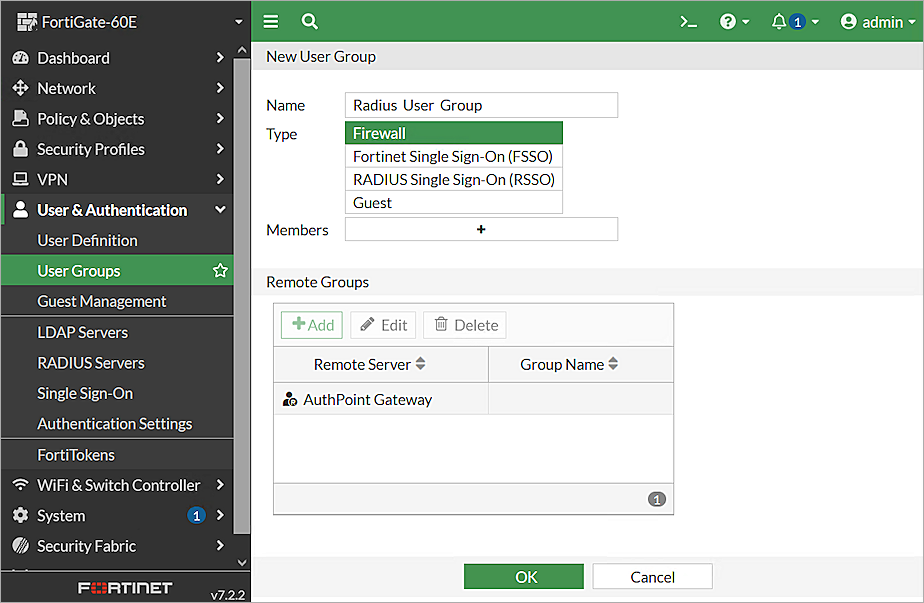
- In the Name text box, type a name. In this example, we type Radius User Group.
- In the Type list, select Firewall.
- In the Remote Groups section, click Add.
- From the Remote Server drop-down list, select the AuthPoint Gateway you created in previous section.
- For Groups, select Any.
- Click OK.
- Click OK.
Configure SSL VPN Settings
To configure SSL VPN settings:
- Select VPN > SSL-VPN Settings.
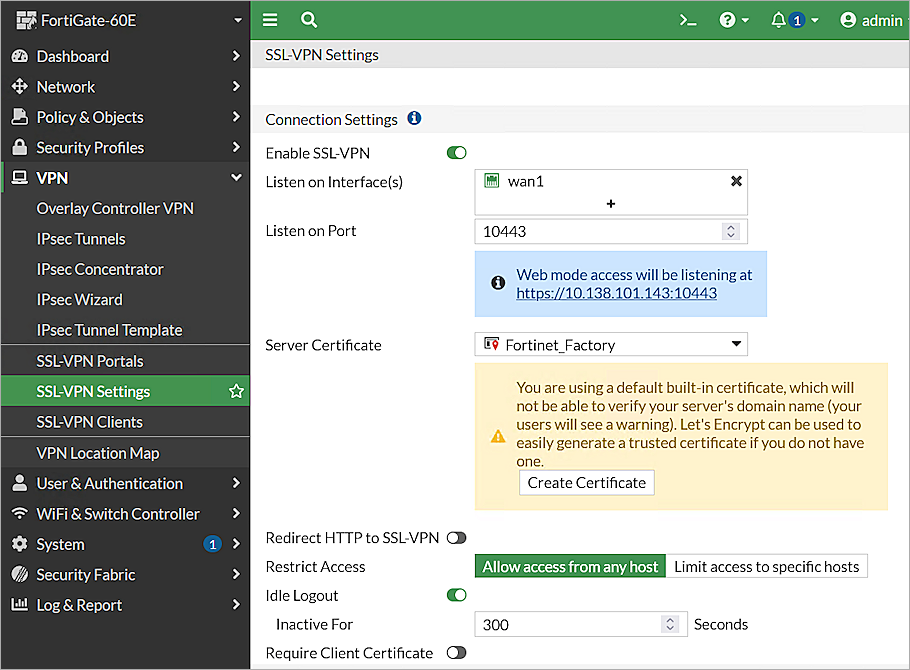
- From the Listen on Interfaces(s) drop-down list, select van1.
- In the Listen on Port text box, type 10443.
- From the Server Certificate drop-down list, select Fortinet_Factory.
- Click the Idle Logout toggle.
- Scroll to Authentication/Portal Mapping section. Click Create New.
- From the Users/Groups drop-down list, select the Radius User Group you created in configuring a user group section.
- From the Portal drop-down list, select full-access.
- Click OK.
- Leave other settings as the default values.
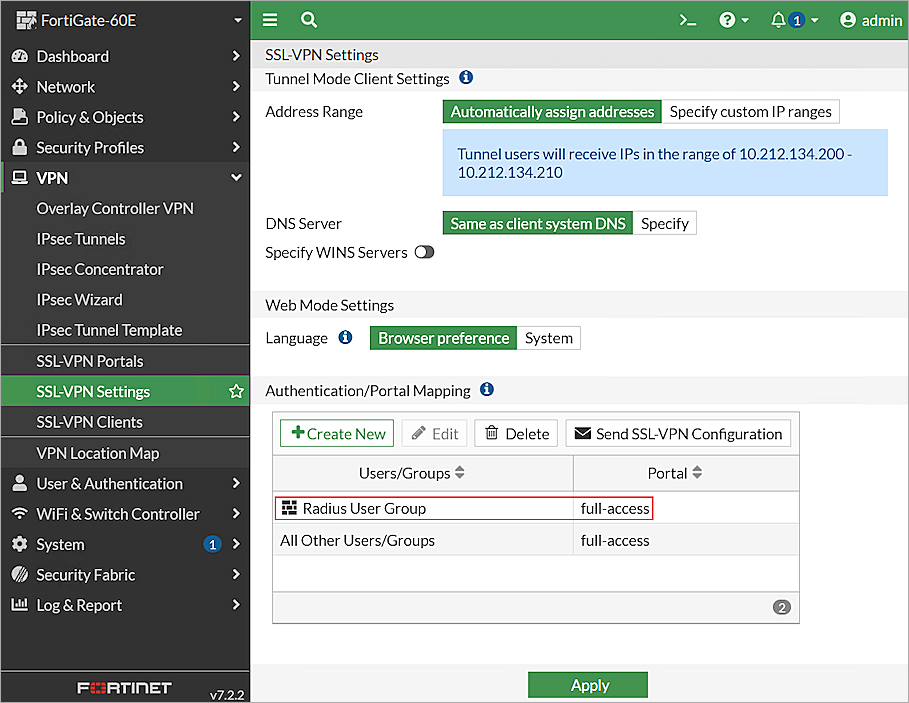
- Click Apply.
Create an SSL VPN Policy
You must create an SSL VPN policy to allow specific users and groups to use the SSL VPN.
To create an SSL VPN policy:
- Select Policy & Objects > Firewall Policy.
- Click Create New.
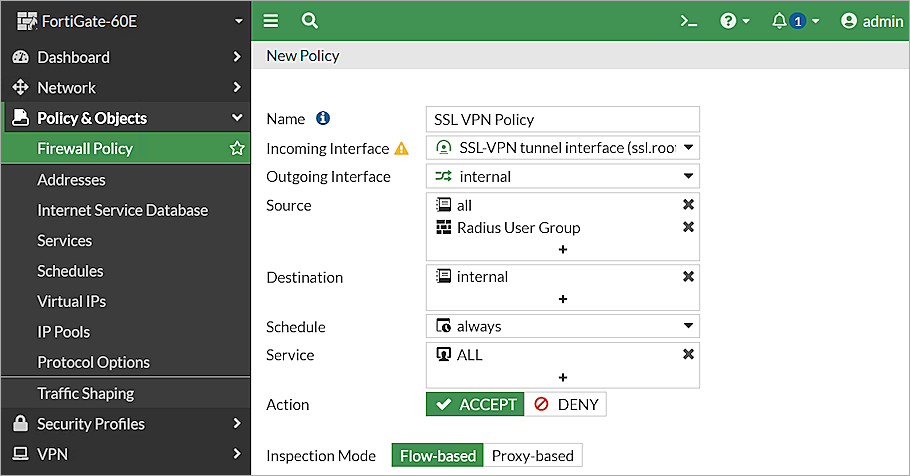
- In the Name text box, type a name.
- From the Incoming Interface drop-down list, select SSL-VPN tunnel interface(ssl.root).
- From the Outgoing Interface drop-down list, select the internal interface connected to the AuthPoint Gateway. In this example, we select internal.
- From the Source drop-down list, for Address, select all. For User, select Radius User Group.
- From the Destination drop-down list, for Address, select the internal protected subnet. In this example, we select internal.
- From the Schedule drop-down list, select always.
- From the Service drop-down list, select All.
- Leave other settings as the default values.
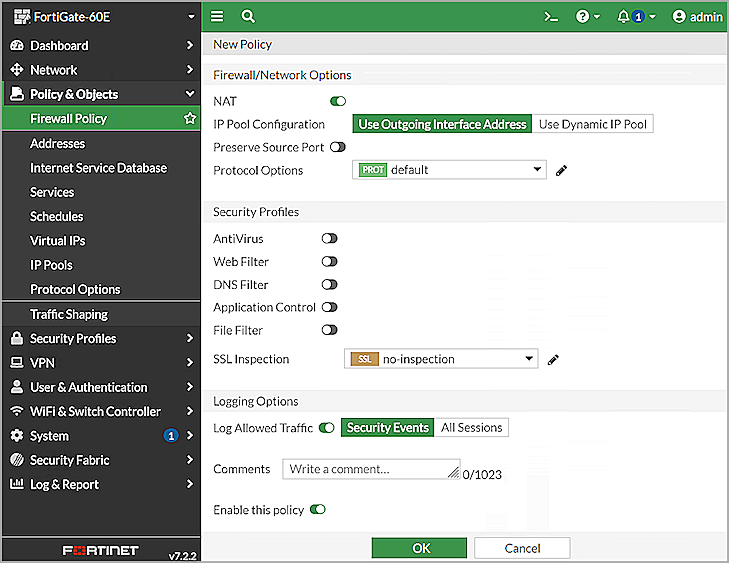
- Click OK.

Configure AuthPoint
Before AuthPoint can receive authentication requests from Fortinet 60E, you must:
- Specify Fortinet 60E as a RADIUS client resource in AuthPoint.
- Add an authentication policy for the Fortinet 60E RADIUS client resource or add the Fortinet 60E RADIUS client resource to an existing authentication policy.
- Bind the Fortinet 60E RADIUS client resource to the AuthPoint Gateway.
Add a Fortinet 60E Resource in AuthPoint
From the AuthPoint management UI:
- From the navigation menu, select Resources.
Click Add Resource.
The Add Resource page opens.

- From the Type drop-down list, select RADIUS Client.
Additional fields appear.

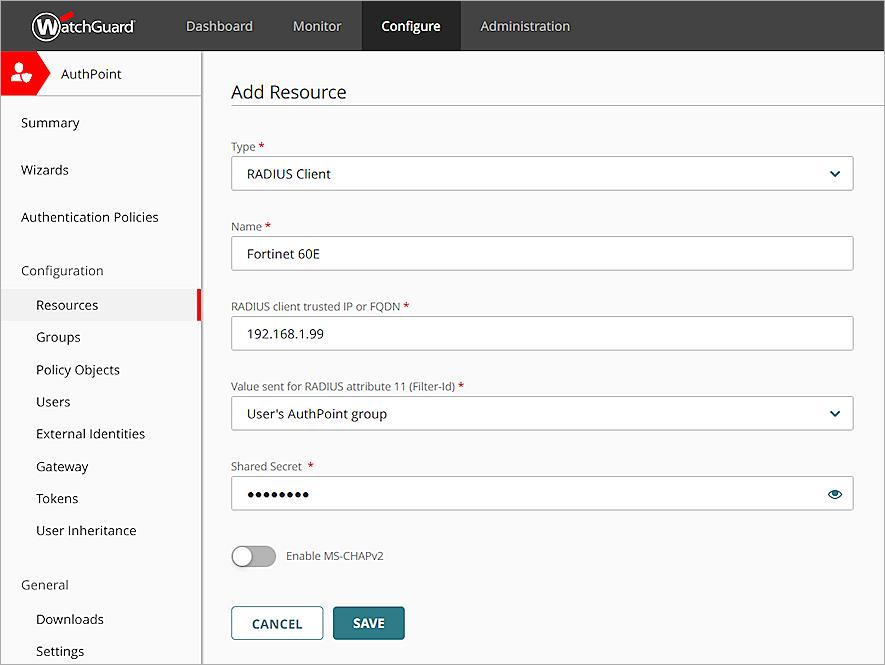
- In the Name text box, type a name for this resource.
- In the RADIUS client trusted IP or FQDN text box, type the FortiGate 60E internal interface IP address. In this example, we type 192.168.1.99.
- In the Value sent for RADIUS attribute 11(Filter-Id) drop-down list, select User's AuthPoint group.
- In the Shared Secret text box, type the shared secret that is same as the one you configured in Fortinet RADIUS Server section.
- Click Save.
Add a Group in AuthPoint
You must have at least one user group in AuthPoint to configure MFA. If you already have a group, you do not have to add another group.
To add a group to AuthPoint:
- From the navigation menu, select Groups.
- Click Add Group.
The New Group page appears.

- In the Name text box, type a descriptive name for the group.
- (Optional) In the Description text box, type a description of the group.
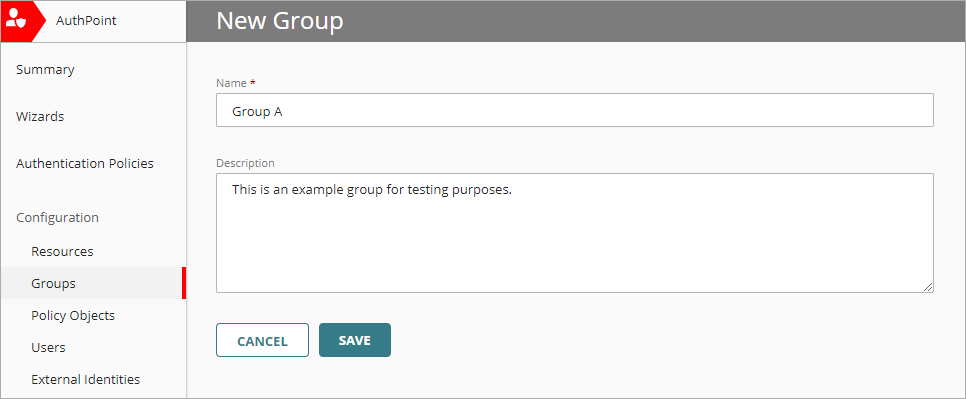
- Click Save.
Your group is listed on the Groups page.
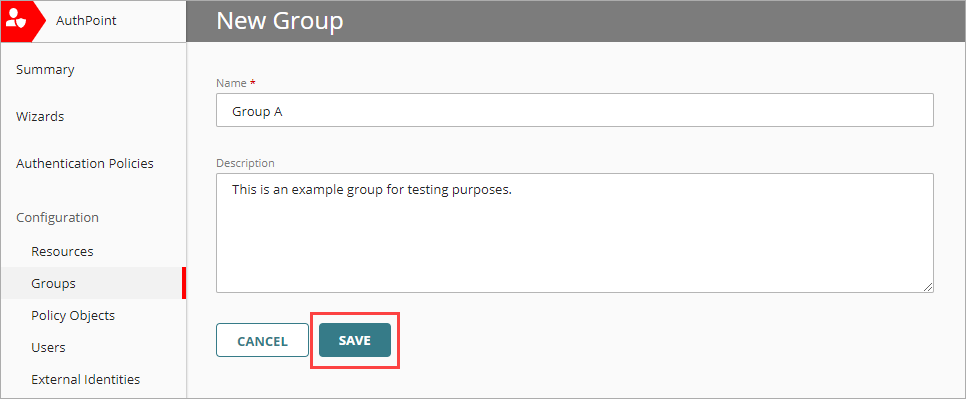
Add an Authentication Policy to AuthPoint
Authentication policies specify which resources users can authenticate to and which authentication methods they can use (Push, QR code, and OTP).
You must have at least one authentication policy in AuthPoint that includes the Fortinet 60E RADIUS client resource. If you already have authentication policies, you do not have to create a new authentication policy. You can add this resource to your existing authentication policies.
Users that do not have an authentication policy for a specific resource cannot authenticate to log in to that resource.
To configure an authentication policy:
- From the navigation menu, select Authentication Policies.
The Authentication Policies page opens.

- Click Add Policy.
The Add Policy page opens.
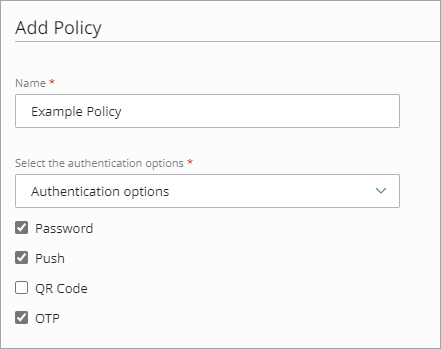
- In the Name text box, type a name for this policy.
- From the Select the Authentication Options drop-down list, select Authentication Options, then select which authentication options users can choose from when they authenticate.
If you enable the push and OTP authentication methods for a policy, RADIUS client resources associated with that policy use push notifications to authenticate users.
QR code authentication is not supported for RADIUS client resources.
- From the Groups drop-down list, select which groups this policy applies to. You can select more than one group. To configure this policy to apply to all groups, select All Groups.
- From the Resources drop-down list, select the resource that you created in the previous section. If you want this policy to apply to additional resources, select each resource this policy applies to. To configure this policy to apply to all resources, select All Resources.
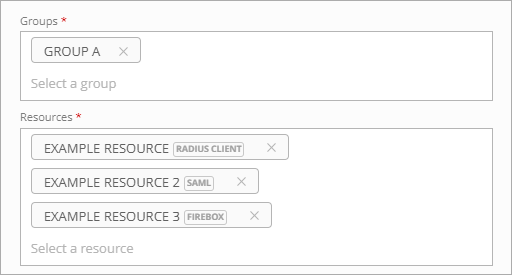
-
(Optional) If you have configured policy objects such as a Network Location, select which policy objects apply to this policy. When you add a policy object to a policy, the policy only applies to user authentications that match the conditions of the policy objects. For example, if you add a Network Location to a policy, the policy only applies to user authentications that come from that Network Location. Users who only have a policy that includes a Network Location do not get access to the resource when they authenticate outside of that Network Location (because they do not have a policy that applies, not because authentication is denied).
For RADIUS authentication, policies that have a Network Location do not apply because AuthPoint does not have the IP address of the user.
If you configure policy objects, we recommend that you create a second policy for the same groups and resources without the policy objects. The policy with the policy objects should have a higher priority.

- Click Save.
Your policy is created and added to the end of the policy list.When you create a new policy, we recommend that you review the order of your policies. AuthPoint always adds new policies to the end of the policy list.
Bind the RADIUS Resource to a Gateway
To use RADIUS authentication with AuthPoint, you must have the AuthPoint Gateway installed on your corporate network and you must assign your RADIUS resources to the Gateway in the AuthPoint management UI. The Gateway functions as a RADIUS server.
If you have not configured and installed the AuthPoint Gateway, see About Gateways.
To bind the RADIUS resource to a gateway:
- From the navigation menu, select Gateway.
- Select the Name of the Gateway.
-
From the RADIUS section, in the Port text box, type the port number used to communicate with the Gateway. The default ports are 1812 and 1645.
If you already have a RADIUS server installed that uses port 1812 or 1645, you must use a different port for the AuthPoint Gateway.
- From the Select a RADIUS Resource drop-down list, select your RADIUS client resource.
- Click Save.
Add Users to AuthPoint
Before you assign users to a group, you must add the users to AuthPoint. There are two ways to add AuthPoint user accounts:
- Sync users from an external user database
- Add local AuthPoint users
Each user must be a member of a group. You must add at least one group before you can add users to AuthPoint.
To import users from Active Directory, Microsoft Entra ID, or an LDAP database, you must add an external identity in the AuthPoint management UI. External identities connect to user databases to get user account information and validate passwords.
- To sync users from Active Directory or an LDAP database, you must add an LDAP external identity
- To sync users from Microsoft Entra ID, you must add a Microsoft Entra ID external identity
When you sync users from an external user database, you can sync any number of users and they are all added to AuthPoint at one time. Users synced from an external user database use the password defined for their user account as their AuthPoint password.
To learn how to sync users, go to Sync Users from Active Directory or LDAP and Sync Users from Azure Active Directory.
You can create local AuthPoint users on the Users page in the AuthPoint management UI. Because you can create only one user at a time, you most commonly do this when you want to create test users or to add only a small number of users.
Unlike users synced from an external user database, local AuthPoint users define and manage their own AuthPoint password. When you add a local user account, the user receives an email that prompts them to set their password.
To learn how to add local AuthPoint user accounts, go to Add Local AuthPoint Users.
Test the Integration
To test the integration of AuthPoint and the configuration of your Fortinet 60E Firewall, you can authenticate with a mobile token on your mobile device. For RADIUS resources, you can select the one-time password (OTP) or push authentication methods.
In this example, we show the one-time password authentication method.
- Start Forticlient.
- Click Configure VPN.
- In the Connection Name text box, type the name of this connection.
- (Optional) In the Description text box, type a description.
- In the Remote Gateway text box, type the IP address of the listen on interface in Fotinet.
- Check Customize port, type 10443.
- In the Client Certificate drop-down list, select None.
- Click Save.
- In the Username text box, type your AuthPoint user name.
- In the Password text box, type your AuthPoint password and your OTP (the OTP for your token shows in the AuthPoint mobile app). Do not add a space between your password and your OTP.
- Click Connect.
